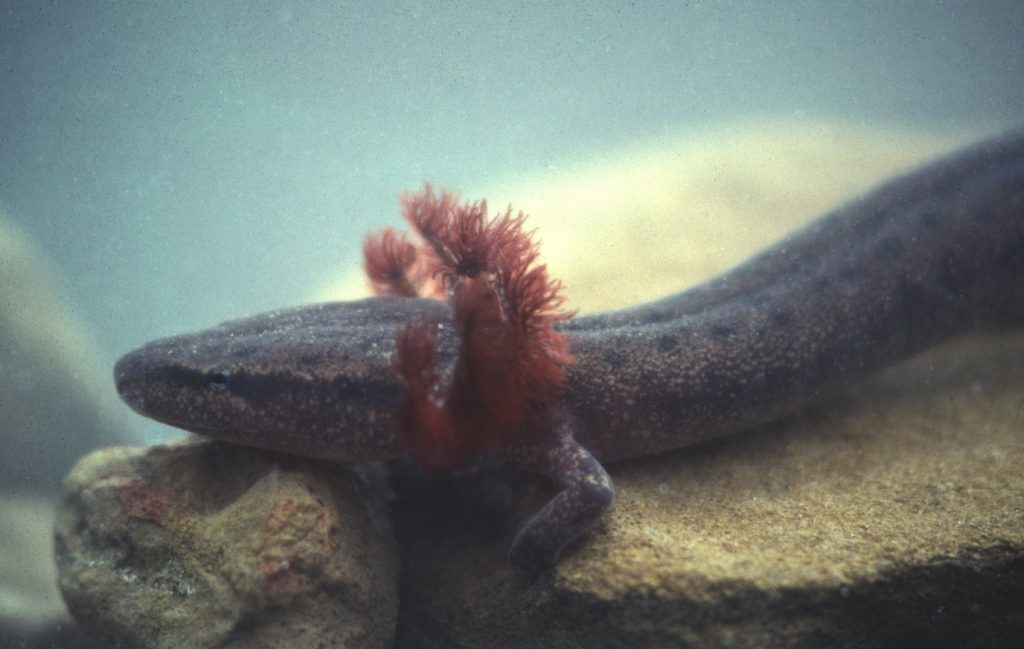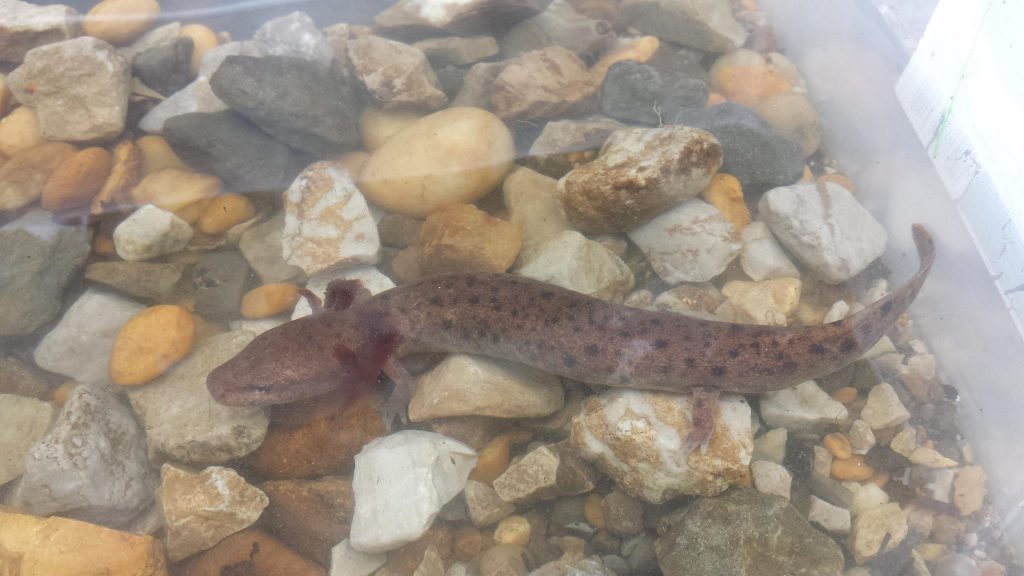Great News for the Black Warrior Waterdog
U.S. Fish and Wildlife Service Proposes Endangered Status & Critical Habitat for Alabama’s Black Warrior Waterdog
News Release by U.S. Fish and Wildife Service: October 5, 2016
Contacts:
Denise Rowell, 251-441-6630, [email protected]
Tom MacKenzie, 404-679-7291, [email protected]
The U.S. Fish and Wildlife Service wants to protect the Black Warrior waterdog as an endangered species under the Endangered Species Act (ESA) because of low population numbers, habitat fragmentation, and poor water quality in the Black Warrior River Basin. An endangered species is considered in danger of extinction throughout all or a significant portion of its range.
At the same time, the Service also is proposing to designate 669 river miles within 11 tributaries of the Black Warrior River Basin as critical habitat. The Service is including a draft economic analysis for this proposed action. The public is invited to submit comments on all of these actions through a 60-day comment period ending December 5, 2016.
The Black Warrior waterdog is not the only species struggling to survive in the Black Warrior River Basin. Fifteen other aquatic species are currently federally protected in the basin’s rivers and streams, including snails, fish, mussels, turtles, and amphibians. The flattened musk turtle, federally-listed as threatened, has habitat needs similar to the waterdog, and the two species’ ranges overlap.
“The decline of the Black Warrior waterdog indicates a decline in water quality,” said Cindy Dohner, the Service’s Southeast Regional Director. “By proposing to conserve the waterdog, we hope to work with partners to improve water quality within the entire basin to benefit people and all aquatic species.”
“We are committed to improving the waterdog’s status and habitat quality in the basin, which helps fish and wildlife, as well as people,” Dohner said.
The Black Warrior waterdog is a large, aquatic, nocturnal salamander that permanently maintains its larval shape and external gills throughout its life. It is only found in streams within the Black Warrior River Basin in Alabama, including the main channel of the Black Warrior River, parts of the North River, Locust Fork, Mulberry Fork, and Sipsey Fork, and all tributaries in this basin.
Water quality degradation is likely one of the biggest threats to the continued existence of the Black Warrior waterdog, and is considered the primary reason for the extirpation of this species over much of its historical range. Because of their highly permeable skin and external gills, waterdogs are particularly sensitive to declines in water quality and oxygen concentration.
Sources of pollution in the Black Warrior River Basin have been numerous and widespread, and include run-off from industrial plants, landfills, sewage treatment plants, construction, forestry management, and surface mining.
Physical features, such as rocks, submerged ledges, and other instream structures, play an important role in determining habitat suitability for the waterdog. One of the most important habitat features is the presence of semi-permanent leaf packs. These provide both shelter and foraging habitat for larval and adult waterdogs.
The Service will make a final decision in 2017 about whether to extend ESA protection to the Black Warrior waterdog after evaluating comments and all available information. In particular, the Service is looking for information on distribution, status, population size or trends, life history, and threats to these salamanders. If the Black Warrior waterdog is listed under the ESA, the Service will work cooperatively with partners to conserve its habitat. In addition, federal agencies would need to ensure that activities they authorize, fund, or carry out are not likely to jeopardize the continued existence of the species or destroy or adversely modify designated critical habitat.
Critical Habitat
The ESA requires the Service to identify specific geographic areas essential for the conservation of the Black Warrior waterdog. All of the proposed critical habitat areas, whether occupied or unoccupied by the waterdog, are within its current or historic range.
Although non-federal lands are included in the areas proposed as critical habitat for the Black Warrior waterdog, activities on these lands will not be affected unless they are authorized, funded, or carried out by a federal agency. In such cases, the lead federal agency will need to consult with the Service to ensure actions do not jeopardize the salamanders or adversely modify their critical habitat.
There are currently 165 river miles of existing critical habitat designated for other species including the Alabama moccasinshell, dark pigtoe, Orangenacre mucket, ovate clubshell, upland combshell, triangular kidneyshell, and Southern acornshell in the basin. The proposed designation will overlap with all of this and will add 504 additional river miles. It is limited to the river itself, within the normal high water mark.
The Service is proposing to designate critical habitat in eight units within the historic range of the Black Warrior waterdog. The recommended critical habitat is located in 11 tributaries within the Black Warrior River Basin. Three of the tributaries are in the Bankhead National Forest (Lawrence and Winston Counties) and include Sipsey Fork, Brushy Creek, and Rush Creek; Locust Fork and Gurley Creek (Blount, Etowah, Marshall, and Jefferson Counties); Blackwater Creek and Browns Creek (Walker and Winston Counties); North River, (Fayette and Tuscaloosa Counties); Yellow Creek and Lye Branch (Tuscaloosa County); and Mulberry Fork (Cullman, Walker, and Winston Counties).
To select these eight units proposed for designation as critical habitat, the Service looked to see where the Black Warrior waterdog was known to occur based on collections and reports commonly referred to as its historic range. Then, Service biologists determined whether the potential critical habitat designation contains the physical and biological features the salamander needs. The physical or biological features provide for a species’ life history processes and are essential to its conservation. Finally, biologists examined the bodies of water that are occupied by the waterdog. Four of the proposed critical habitat units are occupied by the waterdog and four are unoccupied by the species, but the waterdog was historically found at these sites, and they contain suitable habitat to support waterdog populations. The waterdog was actually collected from the four unoccupied critical habitat units in the 1990’s but none have been collected in recent times.
Designating critical habitat informs landowners and the public about specific areas that are important to a species’ conservation and recovery. The Service determines critical habitat based on what an animal or plant needs to survive and reproduce by reviewing the best scientific information concerning a species’ present and historical ranges, habitat, and biology.
Designations have no impact on landowner activities that do not require federal funding or federal permits. The designations do not affect land ownership, nor do they allow government or public access to private land. Additionally, impacts to ongoing activities should not be significant because agencies are already consulting on all of these species and existing critical habitat.
Economic Analysis
As part of the rulemaking process, the Service must consider the economic impacts including costs and benefits of the proposed designation of critical habitat. The economic analysis for the Black Warrior waterdog estimates the critical habitat designation is unlikely to result in a significant economic impact in any given year. Most of the estimated costs are administrative in nature and only applicable when projects may diminish the conservation value of the habitat. The costs are borne largely by federal agencies, which are required to consult with the Service when a project they are funding, permitting or working on is located in an area where critical habitat is designated.
According to the draft economic analysis, for the Black Warrior waterdog, the estimated costs of the designation range from $410 to $9,000 per consultation. The proposed listing of this species with proposed critical habitat is part of the Service’s effort to complete work on a court-approved work plan that resolves a series of lawsuits concerning the agency’s ESA Listing Program. The intent of the agreement is to significantly reduce litigation-driven workloads and allow the agency to focus its resources on the species most in need of the ESA’s protections. For more information, please see http://www.fws.gov/southeast/candidateconservation/.
The ESA allows anyone to petition the Service to include a species on the endangered species list. The proposal to list the Black Warrior waterdog with critical habitat comes as the Service works through hundreds of requests that have come from outside groups in recent years. In responding to these requests, the Service is taking a two-pronged approach of evaluating the petitions as required by law and emphasizing conserving plants and animals before they need the protection of the Endangered Species Act. This has led to a broader partner-driven effort in the Southeast to more fully use flexibilities within the Endangered Species Act to put the right conservation in the right places, benefit imperiled species, keep working lands working and reduce regulatory burden. Since the beginning of the Service’s focus on these at-risk plants and animals, more than 75 species have not required listing as a result of conservation efforts, additional information, reevaluation of stressors, or withdrawn petitions.
The complete listing and critical habitat proposals, as well as a copy of the draft economic analysis for the waterdog’s critical habitat designation, can be obtained by visiting the Federal eRulemaking Portal: http://www.regulations.gov at Docket Numbers FWS-R4-ES-2016-0029 (proposed listing) or FWS-R4-ES-2016-0031 (proposed critical habitat). A copy can also be obtained by contacting U.S. Fish and Wildlife Service, 1208-B Main Street, Daphne, Alabama, 36526.
Comments and information may be submitted by: (1) online at http://www.regulations.gov by entering FWS-R4-ES-2016-0029 (proposed listing) or FWS-R4-ES-2016-0031 (proposed critical habitat) in the search box and then clicking on “Comment Now”; or (2) mail or hand deliver to U.S. Fish and Wildlife Service, Public Comments Processing, Attn: FWS-R4-ES-2016-0029 (proposed listing) or FWS-R4-ES-2016-0031 (proposed critical habitat), U.S. Fish and Wildlife Headquarters, MS: BPHC, 5275 Leesburg Pike, Falls Church, VA 22041-3803. All comments must be received on or before December 5, 2016. Requests for a public hearing must be made in writing within 45 days by November 21, 2016, to the Falls Church, VA, address.
All relevant information received during the open comment period from the public, government agencies, the scientific community, industry, or any other interested parties will be considered and addressed in the Service’s final listing determination for the Black Warrior waterdog and the identification of habitat essential to its conservation.
The mission of the U.S. Fish and Wildlife Service is working with others to conserve, protect, and enhance fish, wildlife, plants, and their habitats for the continuing benefit of the American people. For more information on our work and the people who make it happen, visit www.fws.gov. Connect with our Facebook page at www.facebook.com/usfwssoutheast, follow our tweets at www.twitter.com/usfwssoutheast, watch our YouTube Channel at http://www.youtube.com/usfws and download photos from our Flickr page at http://www.flickr.com/photos/usfwssoutheast.
-FWS-
Black Warrior waterdog Species Profile
Proposed Listing Questions and Answers
More information about Endangered Species in the Black Warrior River Basin














